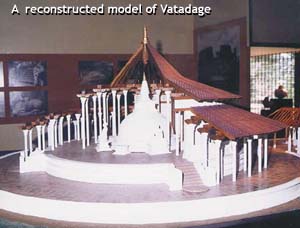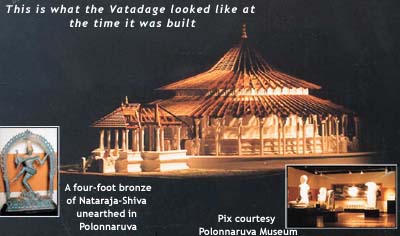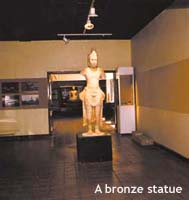 |
 1st November 1998 |
Front Page| |
 A glimpse of glory |
Contents
|
|
 |
The Polonnaruva Museum came to life last week. Tharuka Dissanaike reportsA glimpse of glory
The Polonnaruva Museum and Visitor Information Centre was ceremonially opened by President Chandrika Kumaratunga yesterday. Beautifully located and laid out, the museum attempts to recreate the grandeur of the Polonnaruva era, the second kingdom of ancient Sri Lanka. Located just below the huge bund of the Parakrama Samudraya (Sea of Parakrama) and by the large irrigation canal which takes the water to fields out in the countryside, the museum is just a stone's throw away from the famed Polonnaruva Rest House. The large car park and terraced garden were still being laid out when we visited the museum last week, all hurried preparation for the arrival of the VIPs over the weekend. The building has been designed in eight sections- each section a different room, linked by a long straight corridor. Between the sections, the corridors have one glass-tiled wall, looking out at the flowing irrigation canal, the grassy slopes of the garden and huge trees outside. The auditorium is the first building, a large room with seating for 50 people. A short video clip will be shown to visitors to enlighten them on the facts of the Polonnaruva period. Copies of the ancient murals at Tivanka Pilima Geya (Thivanka Image House) adorn the auditorium walls. The next room or section will have a huge topographical model of Polonnaruva, encompassing all its historic monuments. Each monument, from the King's Palace to Pothgul Vehera to the Tivanka Image House has been made to scale and placed on a room-size model, with a wall map with the name boards for reference. "Here we are trying to give visitors an instant idea about Polonnaruva and the ancient citadel's layout in relation to the tank," said P.L. Prematilleke, retired Professor of Archaeology at the Peradeniya University, who was largely responsible for the high standard of exhibits in the museum. The next section is dedicated to the palace of Parakramabahu, the great Polonnaruwa king. The palace is reconstructed, in much smaller scale, of course, to show visitors what it would have looked like in its heyday, as a seven storied brick structure, with a pagoda-shape tiled roof and a wall right round. Here you see many interesting findings which were unearthed in excavations around the palace site. Coins, with various kings' insignia, roughly hewed stone cannon balls, jewellery and stone scripts. In the next chamber, a perfect model of the reconstructed Vatadage dominates. The model, easily the best of the five reconstructions of monuments in the museum, shows a Vatadage with a pagoda-shaped roof and doorways through which worshippers could enter the inner precincts of the shrine room. Another interesting exhibit is the Polonnaruva Hospital, known as Alahana Pirivena. Only the foundation of the building exists, but excavations have revealed surgical equipment, fine cutting and grinding instruments, a "beheth oruwa" (a body-shaped tub in which to immerse patients in herbal concoctions) and human skeletal remains.
The Polonnaruva age was known also for its fine pottery work. Several large displays of cleverly worked terra-cotta can be seen. The museum is complete with a canteen and modern toilets. The Central Cultural Fund hopes to attract many round-trip tourists and large numbers of Sri Lankans to this Centre. The Dutch government contributed enormously to the museum. Dr. Roelof Munneke, of the Dutch museum of Ethnology provided expertise and more funding came in the way of sophisticated display cases, lighting and photography. The Rs. 40 million project was conceived during the time of Dr. Roland Silva and has taken around two years to complete.
More Plus * Stafford's rollicking Sindbad surpasses them all - Drama Review * 'With Maya': Eva's fresh signature in poetry - Book Review
Front Page| News/Comment| Editorial/Opinion| Business| Sports | Mirror Magazine |
|
 |
Please send your comments and suggestions on this web site to |
|
 It's
reputed to be one of the best site museums in Asia. The Polonnaruva Museum,
says Senaka Bandaranayake, Director General of the Central Cultural Fund
could be "immodestly assessed" to be the best museum that has
come up in the country since independence.
It's
reputed to be one of the best site museums in Asia. The Polonnaruva Museum,
says Senaka Bandaranayake, Director General of the Central Cultural Fund
could be "immodestly assessed" to be the best museum that has
come up in the country since independence. A
large collection of bronze statues are on display in the last section.
"We are grateful to Dr. S.U. Deraniyagala of the Archeological Department
for releasing bronzes which have been found in earlier excavations,"
Prematilleke said. Among these are a four-foot statue of Nataraja-Shiva
and a very intricately detailed one of God Ganesh. Several miniscule statuettes
are also on display.
A
large collection of bronze statues are on display in the last section.
"We are grateful to Dr. S.U. Deraniyagala of the Archeological Department
for releasing bronzes which have been found in earlier excavations,"
Prematilleke said. Among these are a four-foot statue of Nataraja-Shiva
and a very intricately detailed one of God Ganesh. Several miniscule statuettes
are also on display.